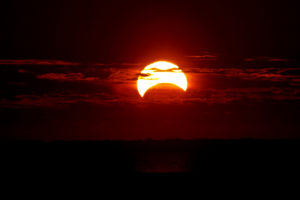 A solar eclipse will be taking place on August 21, and it will be the first total solar eclipse in the US since 1979. During a total eclipse, the moon moves between the Earth and the sun and covers the latter completely, so only the sun’s corona can be seen.
A solar eclipse will be taking place on August 21, and it will be the first total solar eclipse in the US since 1979. During a total eclipse, the moon moves between the Earth and the sun and covers the latter completely, so only the sun’s corona can be seen.
As the moon passes from the West Coast to the East Coast, people in about 14 states will be able to view the total eclipse as it is, while people outside see those states will see a partial eclipse. The total eclipse will cover an area about 70 miles wide as it moves along its path. The total eclipse will be first seen at Yaquina Head on the coast of Oregon. It will move south and east across the United States and eventually end at Cape Island off the coast of South Carolina – a 3,000-mile trip. Other states in which people can view the total eclipse include Idaho, Wyoming, Nebraska, Kansas, Missouri, Illinois, Kentucky, Tennessee, Georgia and North Carolina.
Scientists will take advantage of the eclipse to study the sun’s corona. A group of them will observe the eclipse from the Gulfstream V jet, a research aircraft which belongs to the National Science Foundation (NSF).
Not surprisingly, people in towns along the path of the totality hope to capitalize on the horde of visitors the eclipse will draw. For example, the citizens of Idaho Falls, Idaho, plan to hold “Moonfest,” a four-day long country music festival that will be held outdoors.
Safety Warnings For Eclipse Watchers
NASA warns would-be observers that gazing at an eclipse without eye protection is dangerous. Only during the brief period of totality, when the moon completely covers the sun, may someone safely look at an eclipse. During totality, the eclipse is about as bright as a full moon and just as safe look at.
But the totality is brief; Illinois’ Shawnee National Forest will enjoy the longest totality of two minutes and 44 seconds. During the rest of the eclipse, the moon will only partially obscure the sun, and such partial eclipses should never be observed without eye protection. Similarly, people should not use unprotected binoculars or telescopes to watch the eclipse.
Ordinary sunglasses, no matter how dark, won’t provide sufficient protection. People should wear special eclipse glasses, and they should put a solar filter over any camera, telescope or set of binoculars they use.











